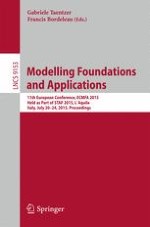This book constitutes the proceedings of the 11th European Conference on Modelling Foundations and Applications, ECMFA 2015, held as part of STAF 2015, in L`Aquila, Utaly, in July 2015. The 13 papers presented in this volume were carefully reviewed and selected from 54 submissions. The committee decided to accept 13 papers, 9 papers for the Foundations Track and 4 papers for the Applications Track. Papers on a wide range of MBE aspects were accepted, including topics such as aspect-oriented modeling, model management, model transformation, advanced meta-modeling, UML modeling tools, and domain-specific modeling w.r.t. energy consumption and cloud-based systems.
